On the Ground in Colorado, NREL Is Simulating Sustainable Aviation Fuel Combustion During Flight
Laboratory Supports Industry in Fine-Tuning Sustainable Aviation Fuel Chemistry Ahead of Seeking Approval for Widespread Airplane Use
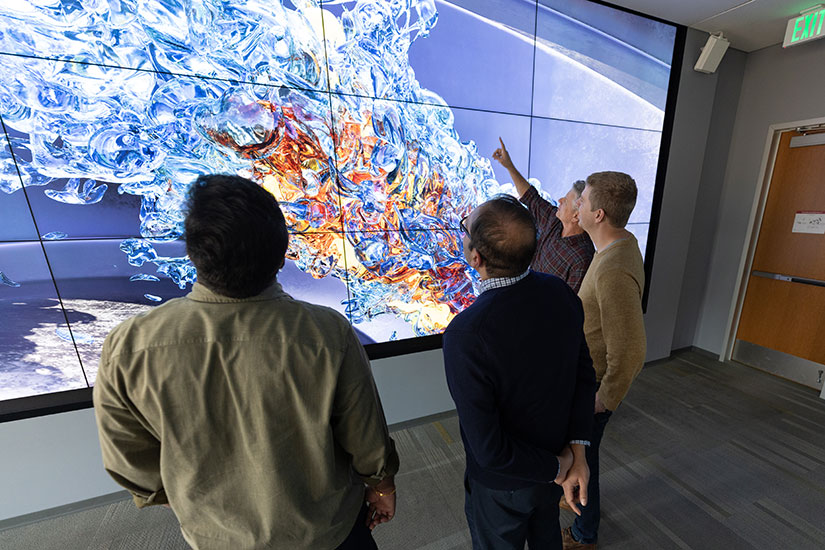
Gasoline became unleaded in the 1970s. The sulfur content of diesel has been lowered over decades. Ethanol has been blended into gasoline for years. The historical timeline of liquid transportation fuels is colored by change after change to fuel chemistry.
However, that cannot be said of petroleum jet fuel. Its properties have changed little since it first became widely used beginning in the 1950s, buoyed by a long record of safety, performance, and ease-of-use.
But changes are coming for jet fuel, and the aviation industry is actively inviting them. Public and private investments are growing to accelerate the production and use of sustainable aviation fuel (SAF), an energy-dense, renewable fuel seen as essential for decarbonizing flight.
Like changes to gasoline and diesel chemistry in the past, adopting SAF means proving the fuel is as safe and reliable as the old stuff—as well as being fully compatible with existing jet engines. For an industry that has built its fleet around a fuel unchanged for 70 years, that could mean a steep learning curve.
"This idea of designing a new jet fuel is like a completely new concept to the aviation industry," said Robert McCormick, a senior research fellow at the U.S. Department of Energy's (DOE's) National Renewable Energy Laboratory (NREL). "Essentially, they've designed the engines around this one fuel: Jet A, which has been the standard petroleum jet fuel for years."
Fortunately, the aviation industry does not have to find a replacement for Jet A alone. In a project supported by the DOE, a cross-disciplinary research team is gathering meticulous fuel chemistry data to equip the industry with an ultra-detailed SAF combustion simulation. Powered by supercomputers, the "virtual jet engine" can predict how SAF performs during flight and provide insights on how to tune it to maximize its safety and performance. The simulations will be validated with data captured in combustion test cells at General Electric and Georgia Institute of Technology.
If successful, the SAF research platform, built using a suite of custom modeling tools called Pele in collaboration with NREL's Computational Science Center, may help industry avoid costly surprises when seeking approval for new SAFs from ASTM International. More fundamentally, it might reveal frontiers never seen before in jet fuel chemistry—insights that could help planes fly further, run cleaner, and perform better than ever before.
Jet Engine Tests "Drink a Lot of Fuel"— Simulations Drink None
To understand the value of NREL's jet fuel combustion program, one must recognize the risk companies face as they perfect the complex chemistry of turning biomass, wastes, and other renewable resources into a liquid fuel. To get approval for a new SAF formula from ASTM International—which sets global jet fuel standards—companies must prove that it meets a set of safety, performance, and operability criteria to prove that it is functionally identical to petroleum jet fuel.
ASTM standards ensure jet fuel—no matter how it is made—can be "dropped-in" to existing airplanes, whether fueled in Denver, Dublin, or Dubai. But proving it meets those standards requires thousands of gallons of SAF for the many qualification tests, including combustion in a lab-scale jet engine combustor (and even a full-scale jet engine).
Making that volume of fuel is a steep proposition for a nascent industry, McCormick explained. Many companies are only now working with milliliters of liquids in the lab as they fine-tune complex chemical processes.
"It just adds another risk on top of everything else—that you're going to scale up and your fuel is not going to meet the property requirements," McCormick said.
It is for that reason that NREL computational science and fuels and combustion researchers decided to team up. For a few years, researchers Marc Day and Shashank Yellapantula had been developing modeling tools capable of predictive simulations of aircraft engine combustors. These tools, collectively named Pele, build on more than 50 years of DOE investments in applied mathematics research to provide a unique, highly accurate, and efficient tool to model complex reacting flows. Recent improvements, supported under DOE's Exascale Computing Project, enable the Pele codes to run efficiently on DOE supercomputers, which are the world's largest and fastest. With a goal of allaying the risk of SAF qualification, Day and Yellapantula used this framework to build a combustion simulation based on a NASA jet engine combustor—an open-source design.
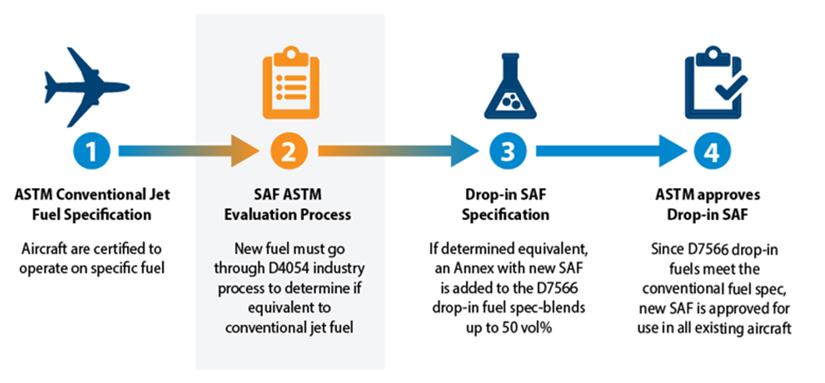
"Engine tests drink a lot of fuel, and they are expensive," Yellapantula said. "Simulations in the short term can provide information that could directly help researchers tune SAF refining processes to get better fuels."
If NREL could simulate SAF combustion tests, Day and Yellapantula theorized, companies could determine if new fuels meet requirements before investing millions of dollars to produce large volumes for ASTM engine tests. The simulations could flag helpful fuel chemistry changes that companies could realize in small-scale lab experiments before building expensive pilot plants to produce these new fuels.
The team had recently simulated combustion within an advanced, high-pressure diesel cylinder—providing new insights on how diesel ignites, burns, and produces air pollutants. With more details on SAF fuel property data, they could regear that same tool for airplane engines.
To validate the model, Day and Yellapantula would need higher-quality fuel property data—data NREL's fuels and combustion researchers are equipped to provide.
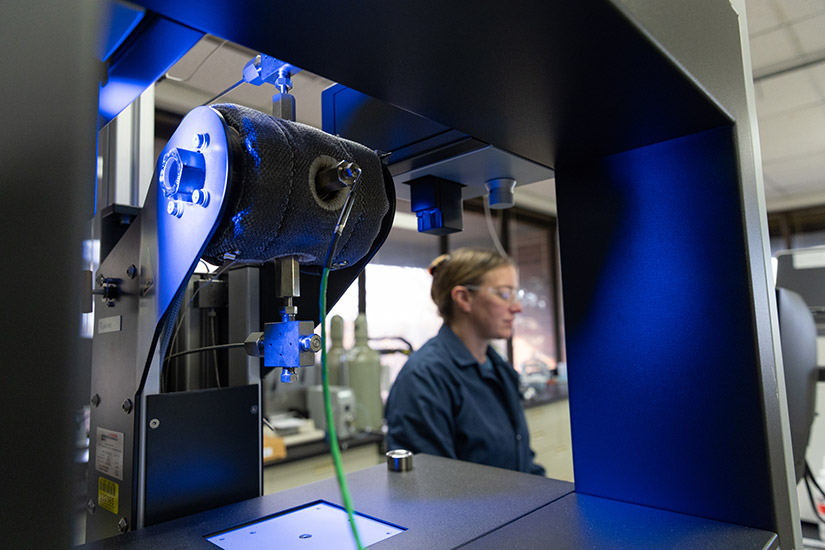
How Detailed Fuel Property Data Will Help Build Out NREL's Simulation
Standing in her lab just blocks away from Interstate 70 in Golden, Colorado, NREL Senior Scientist Gina Fioroni—a colleague of McCormick—rests a hand on a shiny machine on a lab bench. It looks brand new—like a top-shelf kitchen appliance just out of the box. A large dial on the front shows pressure readings up to 8000 psi.
"This is a new frontier in SAF property measurements," Fioroni says.
It is an exceedingly rare piece of machinery—with only one other in the world with a similar configuration. It has an equally particular purpose: measuring the surface tension of liquids at extremely high pressures across a wide range of temperatures.
Using the equipment's high-speed camera, Fioroni can film tiny droplets of jet fuel as they disperse into a chamber. Adjusting pressures and temperatures allows her to mimic the range of conditions jet engines experience during flight—from the atmospheric pressure of an engine resting at sea level to one propelling an aircraft forward 550 mph through the thin and frigid air at 40,000 feet.
As it turns out, understanding SAF surface tension is critical for flight safety and reliability.
"If the fuel or engine is really cold and the engine blows out, you have to be able to relight it instantly," she says. "So the industry needs to clearly understand what is happening at those [high-altitude] conditions."
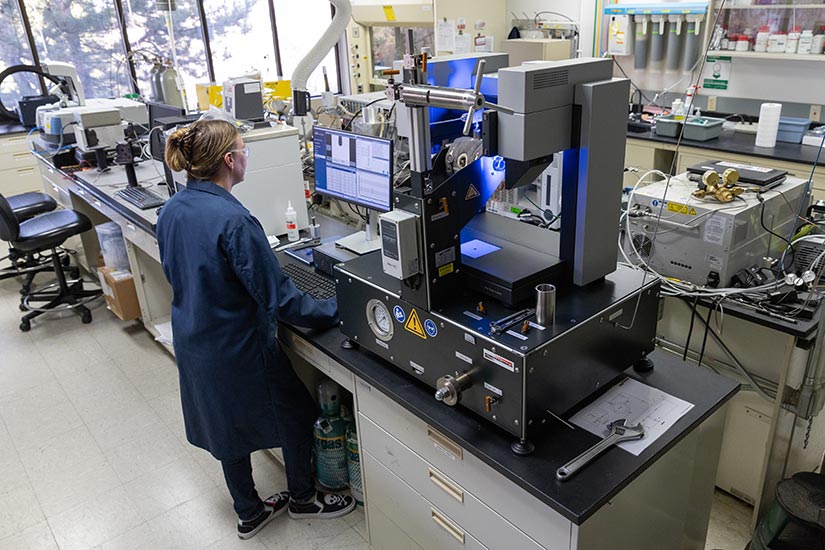
Such specific situations are of keen interest to NREL's fuel properties researchers, but data is scant. Fioroni said that ASTM jet fuel requirements are classically measured at atmospheric conditions. The scientific literature offers few clues on how jet fuel behaves during takeoff, cruising, landing—when engines experience different operating temperatures and pressures.
To build out NREL's combustion simulation, researchers will need to use a range of custom equipment to expose SAF to a range of punishing conditions and gather data on its response. On a neighboring lab bench, a flow reactor with a gas chromatography system can reveal complex SAF kinetics—such as how fast it burns and the soot and pollutants it releases. In a lab down the hall is a high-pressure viscometer, another custom-built tool the team pairs with environmental chambers to measure fuel viscosity at subzero temperatures.
Together, the equipment allows SAF to be profiled with unprecedented detail, under expected conditions in jet engines, and by only using a few milliliters of fuel.
Team To Simulate Already Commercialized SAF Before Moving to Newer Fuels
Already, Fioroni, McCormick, and colleagues are busy analyzing a kind of SAF already approved by ASTM: hydroprocessed esters and fatty acids synthetic paraffinic kerosene, or "HEFA-SPK." HEFA-SPK is SAF made by hydrotreating plant and animal oils, yellow and brown greases, and waste fat, oil, and greases. ASTM approved it for commercial use in July 2011, although only when blended with conventional jet fuel.
Using the data the fuel properties team provides, Yellapantula will pull the information into NREL's simulations to start exploring its behavioral quirks—from how it disperses in the engine to the kinetics and pollutants it releases as it burns. His team can then adjust the fuel parameters in the computer to understand the limits of its performance.
"We want to see if our simulations match what NREL's fuels and combustion team is measuring," Yellapantula said. "Then once we have that confidence in our simulation model, we could start to expand our analysis and look at newer fuels."
As is critical for any model, though, the team will need to validate the results of their HEFA-SPK simulations in the real world. To do this, partners at General Electric and Georgia Institute of Technology will combust HEFA-SPK in a single aircraft engine combustor test cell—observing its impact on combustor performance over a range of conditions. They will then compare these data to the simulation results. That external work is funded by the U.S. Federal Aviation Administration and NASA as part of a larger effort to characterize SAF impact on the ignition and stability of flames within aviation gas turbine combustors.
Where Is Fuel Combusted?—NREL's simulation focuses on the combustion chamber, where fuel and air mix and—ideally—burn at a constant pressure. Graphic by Josh Bauer, NREL
"If we trust the simulation, we can actually start to explore parameter ranges for fuels that don't exist yet but that maybe industry could make with small changes to their refining processes," Yellapantula added. "We can turn our simulations into suggestions on what to make in the next batch in the lab."
Another important value may be to uncover fuel chemistry adjustments ASTM might use to loosen its blending limits for HEFA-SPK. The organization currently sets a blend limit of 50% with Jet A. Pushing the limit higher—ultimately to 100% SAF—would support deeper reductions in carbon emissions.
After validating the model with HEFA-SPK, the team plans to "combust" other, newer SAFs in the virtual jet engine. They can then start adjusting their properties—viscosity, surface tension, density—to help fuel refiners understand what properties they need to meet and still get efficient engine operation.
"We might be able to say, ‘if you can reduce your viscosity by X, you will get better performance,'" Fioroni said. "Then they can go back to the process to change viscosity by targeting specific chemical structure and design their fuel to get those ideal properties."
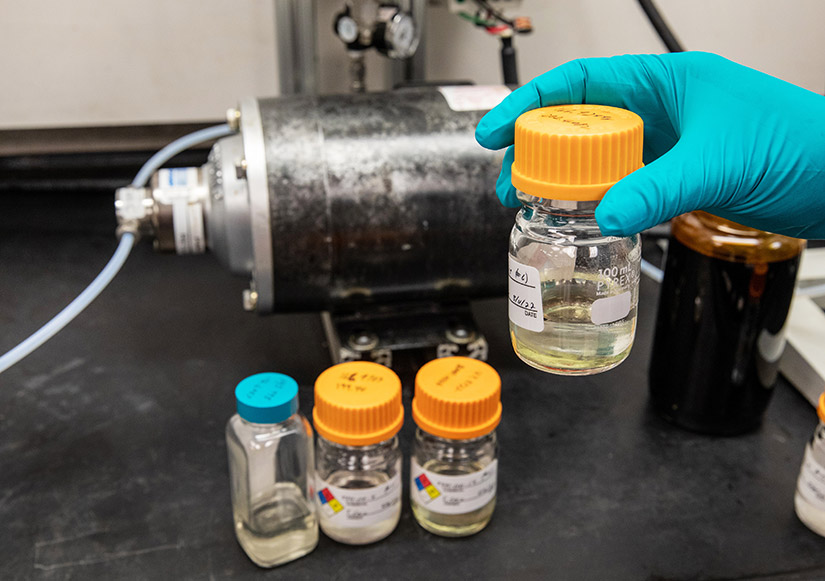
A Tightly Closed Research Loop for Accelerating Bold SAF Goals: 35 Billion Gallons by 2050
Like changes to gasoline and diesel for ground vehicles, the aviation industry is embracing the opportunity of cleaner fuels. Large U.S. airlines have unveiled large investments to support high-profile SAF demonstration projects. The federal government's SAF Grand Challenge sets a national goal of supplying sufficient SAF to cover 100% of projected aviation fuel demand in 2050—an estimated 35 billion gallons annually.
HEFA-SPK—currently used in select markets in California—could be advantageous for increasing SAF adoption quickly around the country. But its supply is likely to be limited by finite supplies of vegetable oils and waste fats, oils, and greases—the primary resources or "feedstock" it is made from.
To grow the market by billions of gallons and overcome barriers to using pure SAF in airplanes, the industry must utilize the full breadth of U.S. renewable feedstocks—from forestry slash leftover from logging operations to agricultural waste, municipal solid waste, and perennial energy crops. Each feedstock has its own complex chemical profile that can impact the properties of the final fuel, creating a highly complicated technical, chemical, and financial challenge, Fioroni said.
"If we want to produce billions of gallons of SAF, we will need to start thinking creatively," she said. "There is only so much biomass, so we need other pathways to develop sustainable jet fuels and to understand how their chemistries work in the engine—especially if we blend beyond what's in the market now."
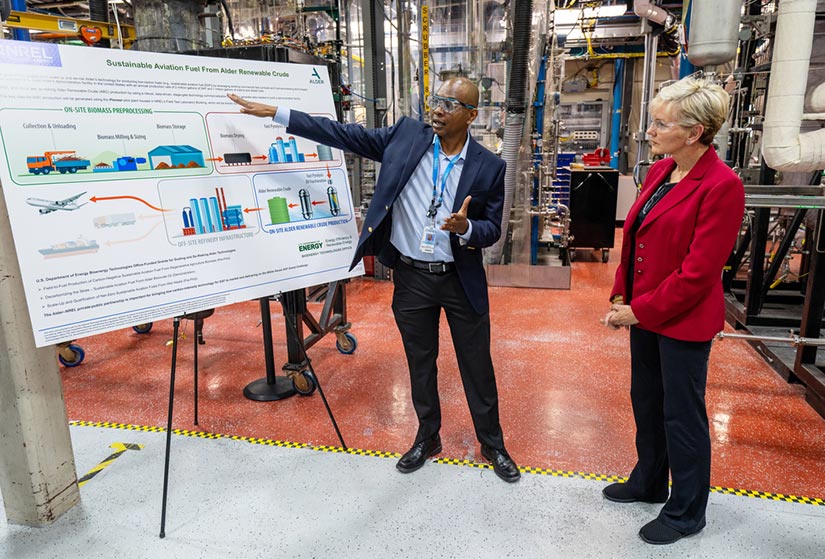
Alongside industry partners, NREL is developing a range of SAF pathways that convert the full breadth of feedstocks—from biomass to other forms of waste carbon like CO2—into SAF that behaves just like petroleum jet fuel. Some can achieve ultra-low carbon footprints, including NREL's technology to turn wet waste into carbon negative SAF. NREL's pilot plants enable industry to scale these processes to prove their viability as commercial processes.
Complementary to these programs, NREL's virtual jet engine could create a tightly closed loop between industry and the simulation for rapid feedback.
"We could provide invaluable insights back to the fuel producers to help them optimize their processes," Yellapantula added. "That way, when they put new fuels forward for certification, the process goes much faster and they can avoid costly surprises."
If achieving ASTM SAF standards feels like digging for a needle in a haystack—or scouring a heap of biomass characteristics for the perfect fuel chemistry—NREL's SAF research makes it like a precise, iterative exercise. As the aviation industry looks to embrace a new jet fuel for the first time in decades, that could be just what is needed to flatten the learning curve ahead.
Learn more about NREL's sustainable transportation and mobility and computational science research, including its broader focus on sustainable aviation research. And sign up for NREL's quarterly transportation and mobility research newsletter, Sustainable Mobility Matters, to stay current on the latest news.
Last Updated May 28, 2025
